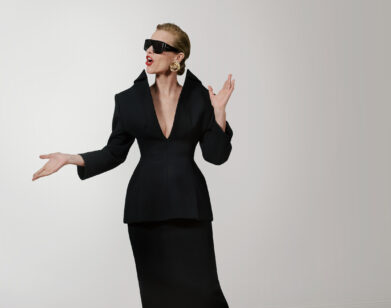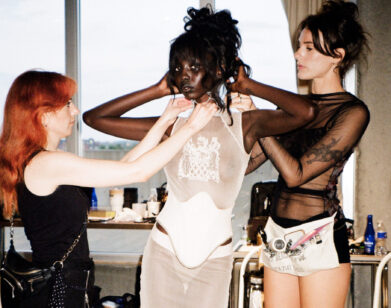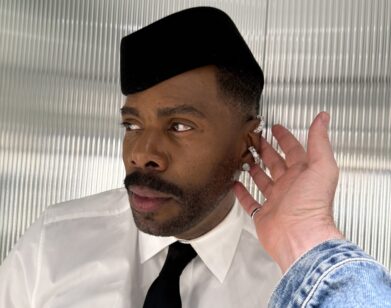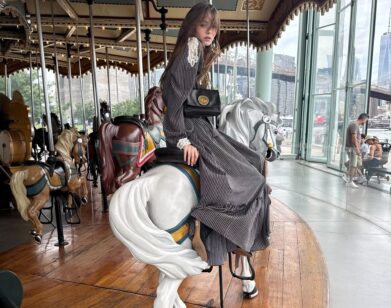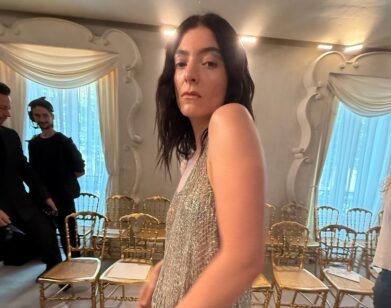Haider Ackermann: The Future of Mystery?
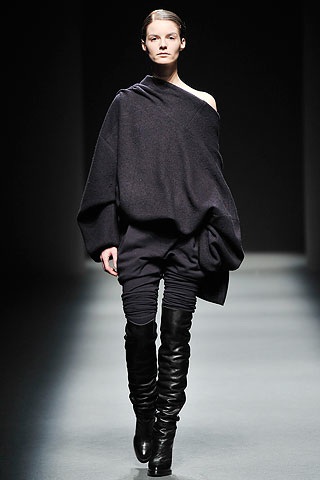
Rumor has it that Haider Ackermann has been tapped to replace the irreplaceable, invisible Martin Margiela. The Columbian-born, internationally-raised and Antwerp-trained Frenchman’s consistently graceful, sculptural, dark and artistic designs have already earned him the admiration of many in Margiela’s base, including Tilda Swinton. “When does a designer go from newcomer to trendsetter?” muses Armand Limnander in a profile of Ackermann for T. However the gargantuan leap from “trendsetter” to a designer able to alter the ideals and norms of his era at Margiela’s level is one that painfully few achieve. So how does Ackermann stack up against a phantom, whose conceptual designs have taught wearers that a nail can double as a stiletto heel, and who made four stitches at the back international code for say-it-without-saying-it subversive style?
So far, Ackermann’s eclectic, sculptural deigns embody an intellectual kind of beauty and make easy comparisons to Rick Owens, Dries Van Noten, and Ann Demeulemeester. Speaking to T, Ackermann sagely (or teasingly?) notes the enormity of Margiela’s legacy, “When you meet the person you have admired for so many years, how can you possibly replace him? Sometimes it’s better never to meet your heroes.”
As many on the Fashion Spot have wondered, we ask if Ackermann is articulating legitimate concerns over his own ability to take over the legendary house? Or does Ackermann’s humility demonstrate the kind of intellectual and emotional maturity that can inspire greatness? Here, we examine representative looks from Ackermann’s Paris catwalk collections for his eponymous line, which he started in Spring 2001, to see whether Ackermann can overcome his reasonable anxiety and prove the rumor-mongers, and those rooting for him, right…
Spring/Summer 2004
Dressing Omahyra Mota in an African-inspired draped top and fluid silk harem pants, before crotches dropped all over the globe, exemplifies Ackermann’s cultivated internationalism. Margiela’s looks tend to be otherworldly but Ackermann has no reason to copy them when he has a whole globe to appropriate and represent.
Fall 2007
“I wanted to take a motorcycle and escape to Tibet,” Ackermann told Style.com when describing the inspiration for his Fall 2007
collection. That was the season when Margiela pioneered towering shoulder pads like twin Mount Everests. Ackermann’s soigné suede, leather and velvet pant suits provided a soft, graceful contrast to Margiela but a few dramatically sculpted jackets met the call for urban warrior wear.
Spring 2008
Margiela provided graphic second-skin geometric tubes, with black-out bands across the models’ eyes. The effect was to transform the models into completely abstracted and disjointed forms of strong color and appealing flesh. In contrast, Ackermann offered shimmery fluid, billowing drapped silk in grays, purples and blues. Its hard to imagine the women wearing these designers inhabiting the same plane, let alone attending the same party. But both sets of looks were bold, sexy and strongly articulated.
Spring 2009
On the year of Margiela’s 20th Anniversary, Style.com’s Nicole Phelps heaped praise on Ackermann’s Paris S/S 09 collection, exclaiming that, “He can drape humble cotton jersey into a twenty-first-century Vionnet, and what he does with leather could make even Rick Owens envious.” The season’s agile body-suits, jackets and dresses with sculptural zips and drapes were daring and more directly molded to the body than in previous seasons. The awe-inspiring effect relied less on cultural appropriation than Ackermann’s own mature and sculptural vision.
Fall 2009
The powerful, dignified garments that Ackermann showed in his most recent collection demonstrated his fully formed identity as a designer with closer aesthetic ties to Rick Owens and other Antwerp designers, than Margiela proper. The consistency in his cosmopolitan influences and ability to balance his will and the integrity of his materials makes him a designer beautifully suited to dress an international intellectual set. The direct ties between his aesthetic and the master Margiela are not overtly evident. But there is no disputing that Margiela deserves better than a successor slavishly sentiment to his own aesthetic. And Ackermann’s craftmanship with unyielding and difficult fabrics amply demonstrates his capability to blaze an exemplary path in fashion’s future.

